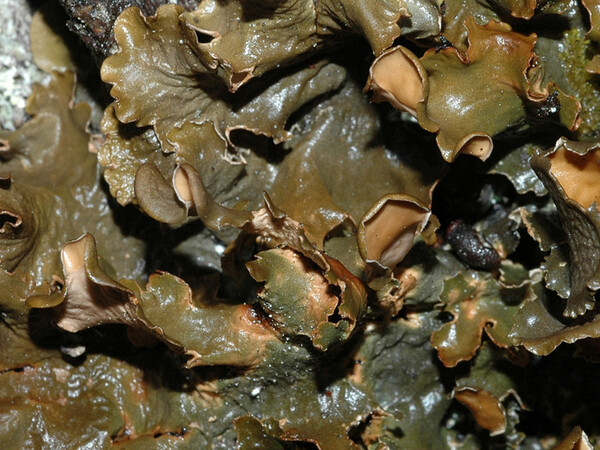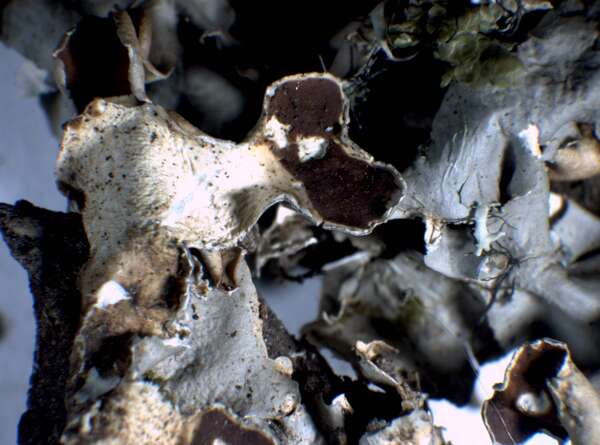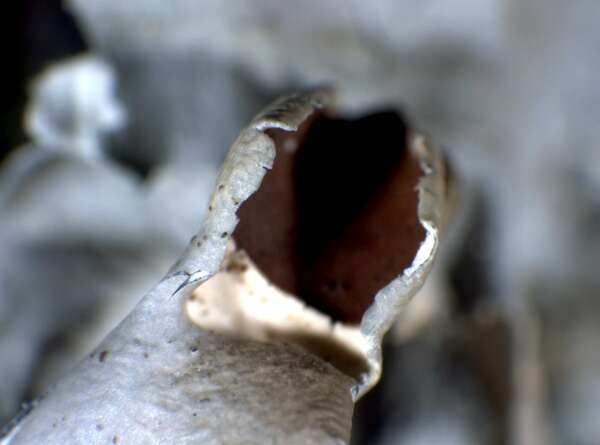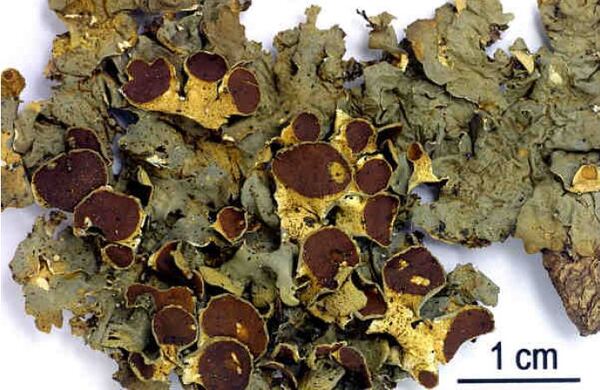Nephroma bellum (Spreng.) Tuck.
Boston J. Nat. Hist., 3: 293, 1841. Basionym: Peltigera bella Spreng. - Caroli Linnaei Syst. Veget., ed. 16, 4, 1: 306, 1827.
Synonyms: Nephroma laevigatum auct. p.p. non Ach.; Nephroma papyraceum auct. p.p.; Nephromium subtomentellum (Nyl.) Cromb.
Description: Thallus foliose, heteromerous, dorsiventral, loosely attached, fragmentary or forming 3-8(-10) cm wide rosettes. Lobes (2-)4-8(-10) mm wide, elongate, partly overlapping, with subrotund, entire or lobulate margins. Upper surface grey-brown to dark brown when dry, much darker when wet, smooth, sometimes slightly pubescent, esorediate; lower surface pale brown to yellow-brown, darker and rugulose in central parts, smooth in marginal parts, mostly glabrous, rarely weakly pubescent in central parts. Upper and lower cortex paraplectenchymatous; medulla white. Apothecia common, immersed on lower surface at tips of lobes, orbicular, to 1 cm across, cup-shaped, with a brown disc and a scabrid thalloid dorsal surface. Epithecium brownish; hymenium and hypothecium colourless. Asci 8-spored, fissitunicate, the thickened apex with a K/I+ blue ring, Peltigera-type. Ascospores 3-septate, pale brown, subfusiform, thick-walled, (15-)17-21(-23) x 4-6 µm. Pycnidia rare, mostly marginal, black, immersed, punctiform. Conidia bacilliform, slightly swollen at one or both ends, 4-5.5 x 1.5-2 µm. Photobiont cyanobacterial (Nostoc, the cells not in long chains). Spot tests: upper cortex K-, C-, KC-, P-; medulla K+ pale yellow or K-, C-, KC-, P-. Chemistry: upper cortex with an unknown brown pigment; medulla with dolichorrhizin, zeorin, hopane-15α,22-diol and traces of hopane-7β,22-diol in variable concentrations.
Growth form: Foliose, broad lobed
Substrata: bark
Photobiont: cyanobacteria, filamentous (e.g. Nostoc, Scytonema)
Reproductive strategy: mainly sexual
Most common in areas with a humid-warm climate (e.g. most of Tyrrenian Italy)
Commonnes-rarity: (info)
Alpine belt: absent
Subalpine belt: absent
Montane belt: very rare
Dry submediterranean belt: extremely rare
Humid submediterranean belt: extremely rare
Padanian area: absent
pH of the substrata:
1 2 3 4 5
Solar irradiation:
1 2 3 4 5
Aridity:
1 2 3 4 5
Eutrophication:
1 2 3 4 5
Poleotolerance:
0 1 2 3
Altitudinal distribution:
1 2 3 4 5 6
Rarity
absent
extremely rare
very rare
rare
rather rare
rather common
common
very common
extremely common
Loading data...
Occurrence data
Predictive map
Growth form: Foliose, broad lobed
Substrata: bark
Photobiont: cyanobacteria, filamentous (e.g. Nostoc, Scytonema)
Reproductive strategy: mainly sexual
Most common in areas with a humid-warm climate (e.g. most of Tyrrenian Italy)
Commonnes-rarity: (info)
Alpine belt: absent
Subalpine belt: absent
Montane belt: very rare
Dry submediterranean belt: extremely rare
Humid submediterranean belt: extremely rare
Padanian area: absent
pH of the substrata:
| 1 | 2 | 3 | 4 | 5 |
Solar irradiation:
| 1 | 2 | 3 | 4 | 5 |
Aridity:
| 1 | 2 | 3 | 4 | 5 |
Eutrophication:
| 1 | 2 | 3 | 4 | 5 |
Poleotolerance:
| 0 | 1 | 2 | 3 |
Altitudinal distribution:
| 1 | 2 | 3 | 4 | 5 | 6 |
Rarity
absent
extremely rare
very rare
rare
rather rare
rather common
common
very common
extremely common
Loading data...
Occurrence data
Predictive map










